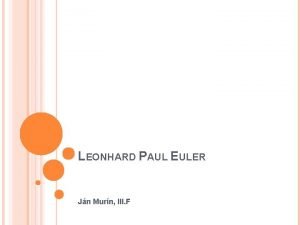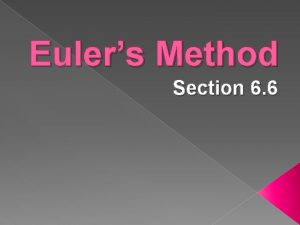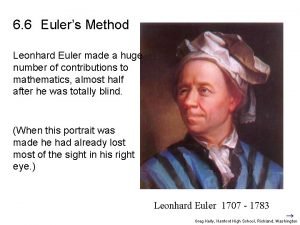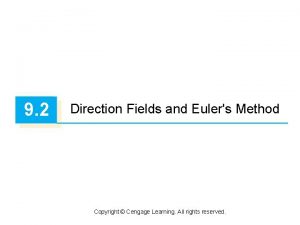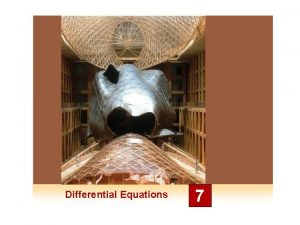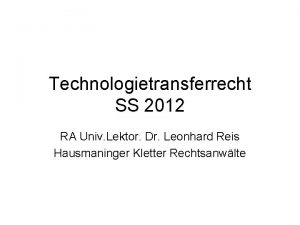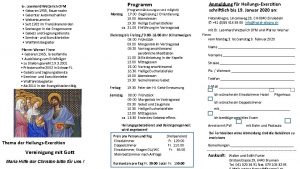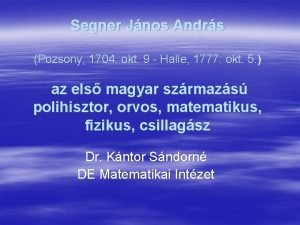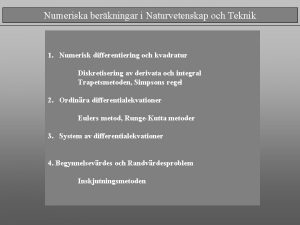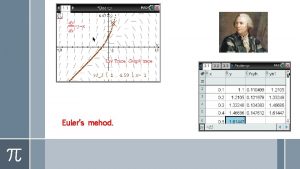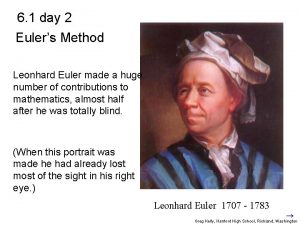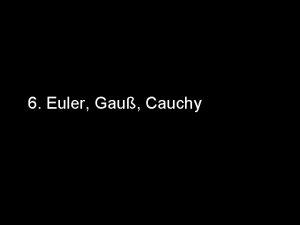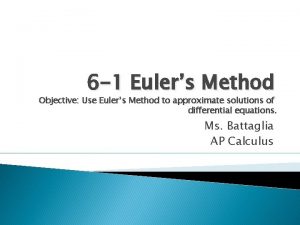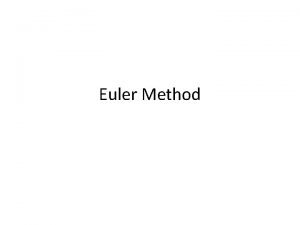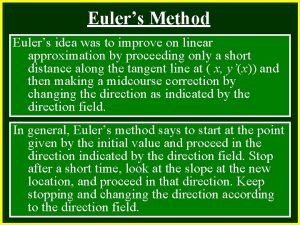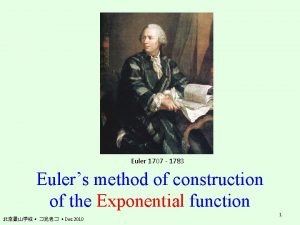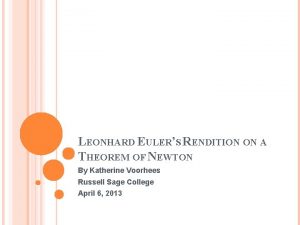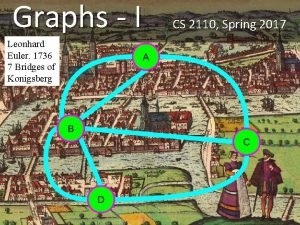6 1 day 2 Eulers Method Leonhard Euler
















- Slides: 16

6. 1 day 2 Euler’s Method Leonhard Euler made a huge number of contributions to mathematics, almost half after he was totally blind. (When this portrait was made he had already lost most of the sight in his right eye. ) Leonhard Euler 1707 - 1783 Greg Kelly, Hanford High School, Richland, Washington

It was Euler who originated the following notations: (function notation) (base of natural log) (pi) (summation) (finite change) Leonhard Euler 1707 - 1783

There are many differential equations that can not be solved. We can still find an approximate solution. We will practice with an easy one that can be solved. Initial value:



Exact Solution:

This is called Euler’s Method. It is more accurate if a smaller value is used for dx. It gets less accurate as you move away from the initial value.

The TI-89 has Euler’s Method built in. Example: We will do the slopefield first: MODE Y= Graph…. . 6: DIFF EQUATIONS We use: y 1 for y t for x

MODE Graph…. . 6: DIFF EQUATIONS We use: y 1 for y t for x Y= WINDOW GRAPH t 0=0 tmax=150 tstep=. 2 tplot=0 xmin=0 xmax=300 xscl=10 not critical ymin=0 ymax=150 yscl=10 ncurves=0 diftol=. 001 fldres=14

WINDOW GRAPH t 0=0 tmax=150 tstep=. 2 tplot=0 xmin=0 xmax=300 xscl=10 ymin=0 ymax=150 yscl=10 ncurves=0 diftol=. 001 fldres=14

While the calculator is still displaying the graph: Press Y= I yi 1=10 WINDOW GRAPH and change Solution Method to EULER. tstep =. 2 If tstep is larger the graph is faster. If tstep is smaller the graph is more accurate.

To plot another curve with a different initial value: F 8 Either move the curser or enter the initial conditions when prompted. You can also investigate the curve by using F 3 Trace .

Now let’s use the calculator to reproduce our first graph: WINDOW I Y= We use: y 1 for y t for x t 0=0 tmax=10 tstep=. 5 tplot=0 xmin=0 xmax=10 xscl=1 ymin=0 ymax=5 yscl=1 ncurves=0 Estep=1 fldres=14 Change Fields to FLDOFF. GRAPH

Use F 3 Trace to confirm that the points are the same as the ones we found by hand. Press Tbl. Set Press Table and set:

Press Table This gives us a table of the points that we found in our first example.

The book refers to an “Improved Euler’s Method”. We will not be using it, and you do not need to know it. The calculator also contains a similar but more complicated (and more accurate) formula called the Runge-Kutta method. You don’t need to know anything about it other than the fact that it is used more often in real life. This is the RK solution method on your calculator. p
 Math leonard norman
Math leonard norman Leonhard paul euler
Leonhard paul euler Day 1 day 2 day 3 day 4
Day 1 day 2 day 3 day 4 Euler's method formula
Euler's method formula Eulers method formula
Eulers method formula Khan academy euler's method
Khan academy euler's method What is modified euler method
What is modified euler method Euler's differential equation
Euler's differential equation Euler path
Euler path Euler trail
Euler trail Day 1 day 2 day 817
Day 1 day 2 day 817 Leonhard reis
Leonhard reis Pater leonhard wetterich
Pater leonhard wetterich Pfarrer werner fimm
Pfarrer werner fimm Cavalieri elv
Cavalieri elv Eulers stegmetod
Eulers stegmetod Eulers andra lag
Eulers andra lag

